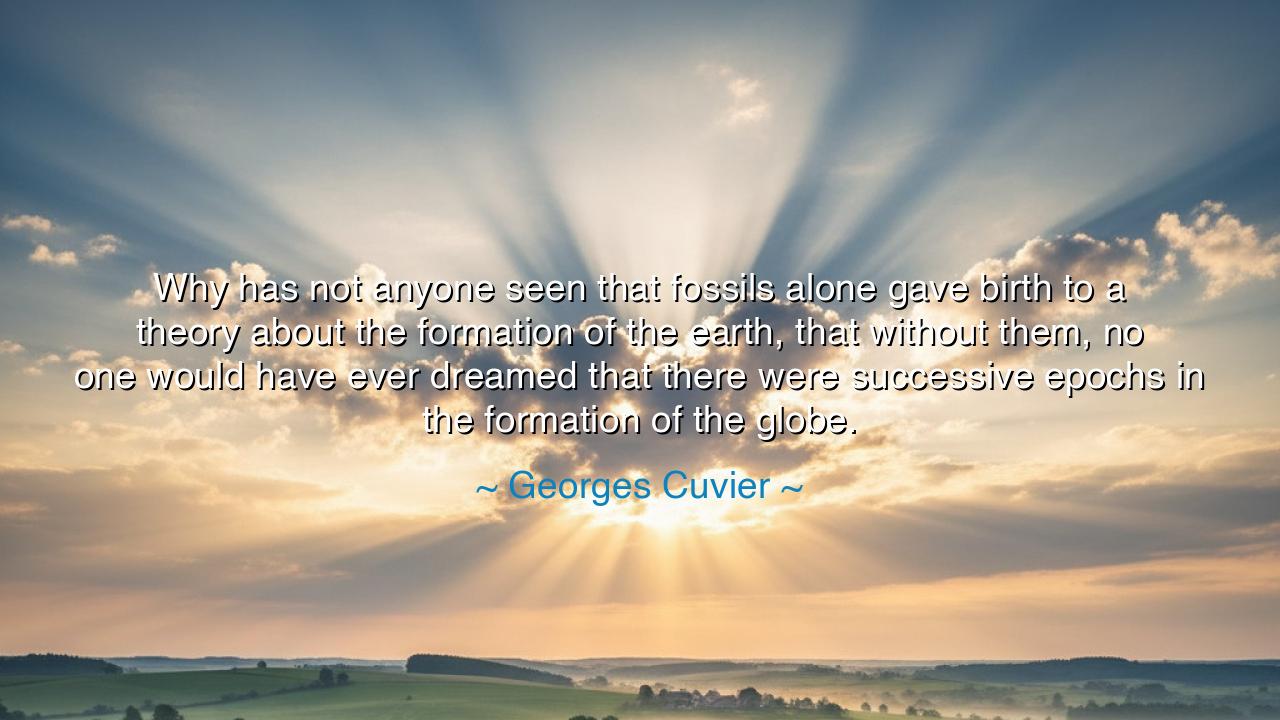
Why has not anyone seen that fossils alone gave birth to a theory
Why has not anyone seen that fossils alone gave birth to a theory about the formation of the earth, that without them, no one would have ever dreamed that there were successive epochs in the formation of the globe.






In the voice of Georges Cuvier, the great French naturalist and father of paleontology, we hear a declaration that bridges the chasm between time and truth: “Why has not anyone seen that fossils alone gave birth to a theory about the formation of the earth, that without them, no one would have ever dreamed that there were successive epochs in the formation of the globe.” These words were not spoken as a boast, but as a revelation—a trumpet call to awaken humankind to the hidden memory of the earth. In them, Cuvier reveals how the stones beneath our feet, long silent, became the first scriptures of deep time, telling a story far older and grander than any man had yet imagined.
Before Cuvier, the earth was often seen as fixed and young—a stage upon which history unfolded briefly before the eternal. Men measured time in centuries, not in epochs. But Cuvier, peering into the bones of ancient beasts and the strata that entombed them, saw something wondrous and terrible: that life upon this world had not always been as it is now; that whole creations had risen, flourished, and perished before humanity drew breath. In the fossil, he found the language of extinction, and from that language he composed a new story of the globe—a story not of constancy, but of transformation. Thus, his question is both astonishment and lament: how could men have lived so long upon this earth and not heard it speak?
The origin of this insight lay in Cuvier’s meticulous study of fossils from the quarries of Paris and the rocks of Europe. Where others saw mere curiosities—odd shapes of stone—he saw evidence of worlds undone. By comparing the skeletons of living and extinct creatures, he discerned the law of correspondence between form and function, establishing the foundations of comparative anatomy. From these bones, he reconstructed vanished creatures—the mammoth, the mosasaur, the mastodon—beings that no man had ever seen alive. The fossils whispered to him of cataclysms, of seas that had swallowed continents and of species lost to time. The earth, he realized, was not static—it was a chronicle of creation and destruction, a theater of successive ages.
This revelation transformed human thought. No longer could the world be seen as the stage of a single, unchanging creation. Instead, it became an ancient book written in stone, whose pages spanned eons. Cuvier’s discovery gave rise to the very notion of geological time, paving the way for the sciences that would follow—Lyell’s uniformitarianism, Darwin’s evolution, the modern understanding of the planet as a living, changing system. It was through fossils alone, as he said, that man first grasped the immensity of time and his smallness within it. The bones of the dead had given birth to the knowledge of eternity.
Yet, there is more in Cuvier’s words than scientific triumph; there is a spiritual awe. To realize that countless worlds preceded ours is to be humbled, to stand in reverence before the vastness of creation. It is to see that we are but one thread in a tapestry woven across the ages. The fossils remind us that life endures through death, that change is the law of being, and that nothing upon this earth is forever fixed. The same forces that buried the giants of the past still shape the mountains and seas of today. In them, we see reflected the cycles of creation and renewal, the eternal dance of loss and rebirth.
Think of the discovery of the first dinosaur bones, unearthed by ordinary hands in the English countryside, long after Cuvier’s time. When the great beasts of the Mesozoic were reconstructed—creatures of power and grace unlike anything alive—humanity’s imagination was forever expanded. These remnants of forgotten ages shattered our narrow view of existence. Just as the astronomer’s telescope opened the heavens, the paleontologist’s hammer opened the deep past. Both revealed that we live not at the center of creation, but as part of an unfolding story far greater than ourselves.
The lesson, then, is twofold: first, that truth often lies buried, waiting for eyes patient enough to see; and second, that humility is the beginning of wisdom. The earth is a teacher whose voice is slow but sure, and its fossils are its ancient words. We, who walk upon its surface, must learn to listen. Let each of us cultivate the spirit of curiosity, the willingness to look beneath the surface—to question, to seek, to understand. For it is through such striving that the hidden order of the universe is revealed.
So, remember this, O seeker of knowledge: the stones beneath you are not silent. They are the memories of creation, the witnesses of time. Cuvier’s insight still stands as a guiding flame: that through the patient study of what is old, we discover what is eternal. The fossils, remnants of worlds long gone, teach us that life is both fragile and enduring, that every ending gives rise to a new beginning. And as long as we keep listening to the earth, as Cuvier once did, we shall never cease to uncover the wonders that lie beneath our feet.






AAdministratorAdministrator
Welcome, honored guests. Please leave a comment, we will respond soon